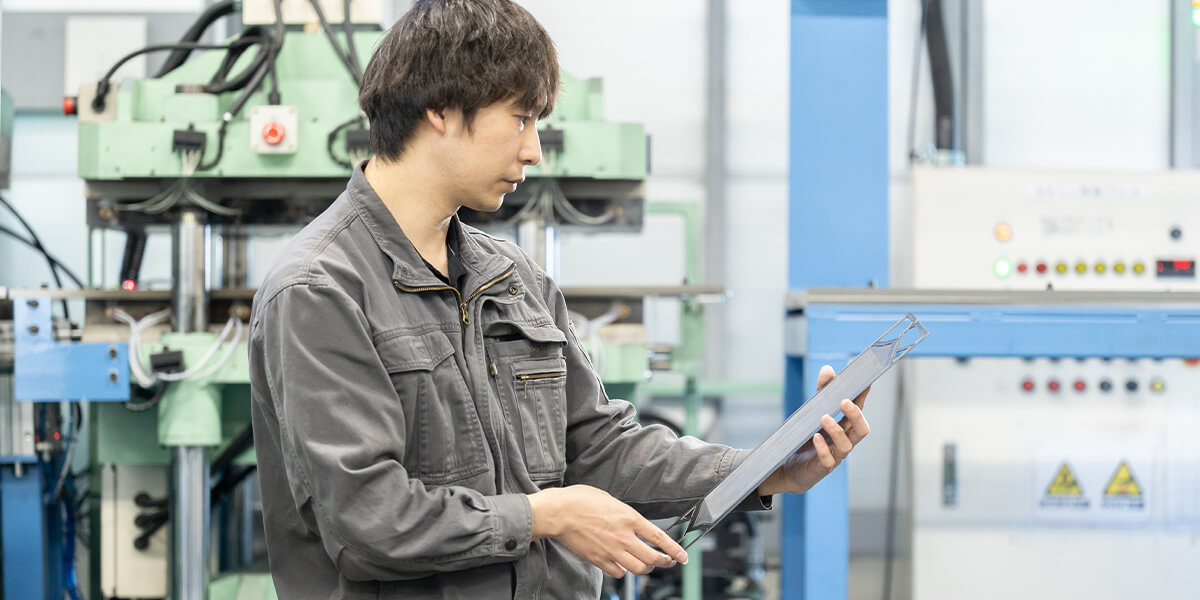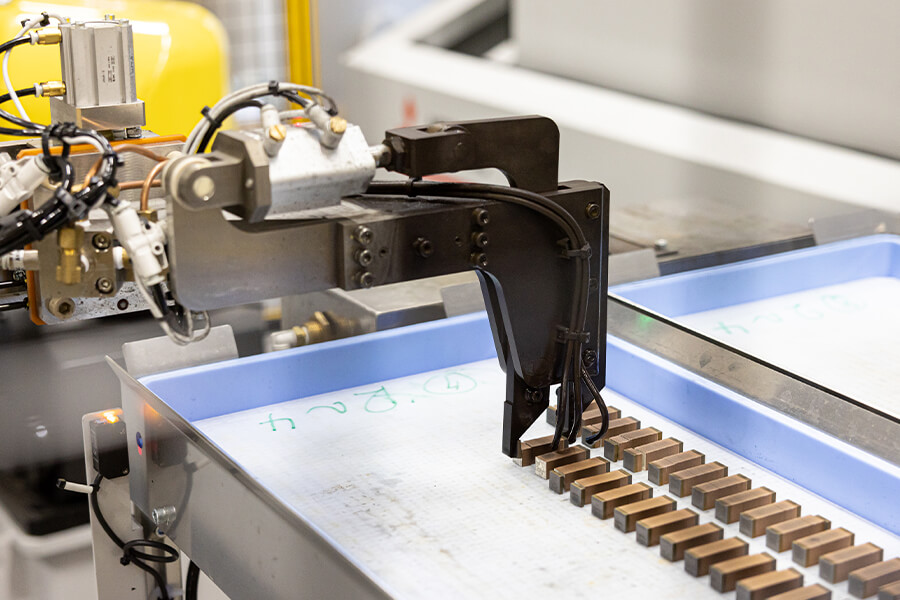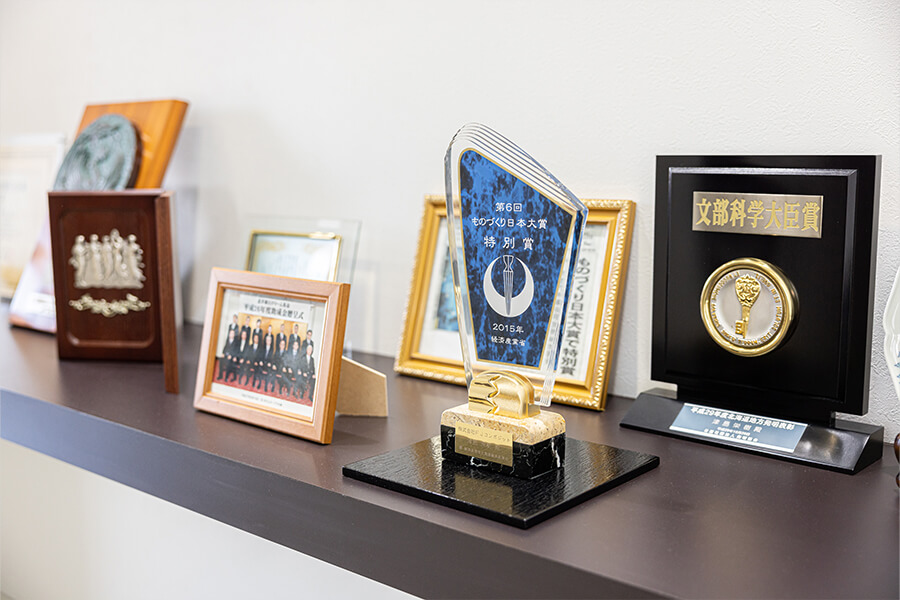TECHNOLOGY
One of our specialized technologies is diffusion bonding, and we have many possibilities for innovation based on our original research and development.

What is Composite?
Creating the next generation
Composite means a combination of several things.
At FJ Composite, we develop new composite materials by mixing and layering of various materials.
A well-known example of composite material is reinforced concrete, which combines steel bars and concrete to create a material that is strong in tension.
By combining the advantages of each raw material, composite materials can be highly functional, which is one of their greatest advantages.

Simple, but difficult manufacturing process of composites
FJ Composite has developed an innovative diffusion bonding method that allows different materials to be bonded without forming an alloy layer. With our technology, highly functional materials can be easily manufactured at a lower cost, which will greatly contribute to the development of society. Our mission is to continue developing new materials that will contribute to the betterment of society.

Bringing future products to the world
In recent years, FJ Composites’ products have become indispensable for “electric vehicles” and “communication devices”, which have seen remarkable technological advances.
Our products are not only used in Japan but also in many other countries around the world.
We are committed to continuing our research and development work and tackling the daily challenge of creating products that contribute to a sustainable society.

For more details on our products and technologies,
please refer to our product pages.
Patents
-
Japan
Manufacturing method of fuel cell separator
(Patent Number:3715642) -
Japan
Fuel cell separator material
(Patent Number:3925806) -
Japan
Manufacturing method of fuel cell separator
(Patent Number:3864158) -
Japan
Surface treatment method for fuel cell separators
(Patent Number:4828821) -
China
Method of producing separator of fuel cell
(Patent Number:3825974.5) -
Japan
Clad material and its manufacturing method
(Patent Number:3862737) -
China
Manufacturing method of fuel cell separator
(Patent Number:20120331100122300) -
USA
Cladding material and its manufacturing method
(Patent Number:US 7951467) -
Europe
Clad material and its manufacturing method
(Patent Number:1944116) -
Hong Kong
Clad material and its manufacturing method
(Patent Number:HK1121989)
Publications
S-CMC®Heat dissipation of LED device by copper-molybdenum composite material
"Monthly Display"
P34-38 2012 Aug.
A material in which copper plates and molybdenum (Mo) plates are laminated in multiple layers and manufactured by diffusion bonding with a hot press furnace can have the same coefficient of thermal expansion as ceramics. In addition, by using multiple layers of Mo, it is possible to greatly reduce the thermal expansion coefficient with a small amount of 5% to 10%, and its thermal conductivity can exceeds 350W/mK. It is a promising packaging material for communication devices (4G, 5G communication, etc.) used in base stations of mobile phones.
At the same time, it is also promising as a heat dissipation material for vertical type LED devices, and its possible application is mentioned.
S-CMC®Development of heat dissipation materials using copper-molybdenum composites
"CSTC NEWS" 2015.04 No.123 Spring issue
It is a memorial document when the 13th Promotion Prize from the Chubu Science Center awarded. the technical content of the S-CMC development background was described in an easy-to-understand manner.
S-CMC®Development of heat dissipation materials using copper-molybdenum composite materials for 5G
"-Towards 5G/Beyond 5G-Latest Development Trends in High-speed and High-frequency Components"
pp.354-371, Technical Information Institute
S-DBCDevelopment of Ceramic Insulating Substrate with Excellent Heat Dissipation by Diffusion Bonding (S-DBC)
" Heat Dissipation/Cooling Technology for electric equipment and Development of Components"
pp.191-200, Technical Information Association
Carbon separator for fuel cell Carbon Molded Separator Plate for Polymer Electrolyte Fuel Cell
"Carbon" 2005 [No.218] P173-177
We have developed a technology to manufacture a separator plate, which is the main component of fuel cell. It consists of carbon powder and phenolic resin. The electrical resistance can be reduced by increasing a carbon content, but when a carbon content exceeds 75%, a gas permeability is greatly deteriorated. The relationship between carbon content and gas permeability was experimentally cleared.
Carbon separator for fuel cell Manufacturing method of carbon/resin mold separator and an effect of resin ratio on its properties
Comprehensive collection of carbon technologies for electronics
P214-220 (published by Technical Information Institute)
We have developed a technology to manufacture a separator plate, which is the main component of fuel cell. It consists of carbon powder and phenolic resin. The electrical resistance can be reduced by increasing a carbon content, but when a carbon content exceeds 75%, a gas permeability is greatly deteriorated. The relationship between carbon content and gas permeability was experimentally cleared.
Carbon separator for fuel cell Low-cost manufacturing technology for PEFC separator plates
"Industrial Materials" vol.51, No.4, P59-61
We have developed a technology to manufacture a separator plate, which is the main component of fuel cell. It consists of carbon powder and phenolic resin. The electrical resistance can be reduced by increasing a carbon content, but when a carbon content exceeds 75%, a gas permeability is greatly deteriorated. The relationship between carbon content and gas permeability was experimentally cleared.
Carbon separator for redox flow battery Research and development of high performance carbon plates for storage batteries, and its high speed production method
Adopted in 2019
Strategic Fundamental Technology Enhancement/Collaboration Support Project Strategic Fundamental Technology Enhancement Support Project
C/C compositeDevelopment of B4C Hybrid-Matrix C/C Composite
J of Materials and Science
Boron-containing C/C materials were developed by adding B4C particles into the matrix of C/C composite materials. It has a neutron gettering effect and is promising as a reactor wall material for nuclear fusion reactors. At the same time, we reported that we observed significant changes in physical properties (hardness and thermal conductivity) due to the boron diffusion phenomenon due to heat treatment.
CFRPFracture Mechanism for High-Modulus Pitch-Based CFRP
Current Japanese Materials Research
Vol.12 P41-57
The relationship between the tensile strength of carbon fiber and that of CFRP was clarified experimentally, and computer analysis was performed. Variation in fiber strength, interfacial adhesive strength, and elastic modulus of resin affect the strength of composite materials, and the strength of composite materials increases when the variation in fiber strength is large, the interfacial strength is low, and the resin is soft.
CFRPFRP compression test method using resin-impregnated strands
The 16th Symposium on Composite Materials, Japan Society for Composite Materials
(Presentation)
A simple method for measuring the compressive strength of CFRP was clarified. After that, a method for measuring the compressive strength of a single carbon fiber was developed, and research progressed to show that the compressive strength of CFRP is determined by the compressive strength of the carbon fiber itself, and that the physical properties of the resin and interfacial strength do not affect it. Those studies were published as joint research with Gifu University (Prof. Osawa, Prof. Miwa).
Awards
| 2017 | Received the Minister of Education, Culture, Sports, Science and Technology Prize for the Hokkaido Regional Commendation for Invention |
|---|---|
| 2015 | Monozukuri Nippon Grand Award Special Award Minister of Economy, Trade, and Industry Award (Cabinet Office) |
| 2015 | Hokuyo Bank Dream Fund Small and Medium Enterprise New Technology Research Grant Received |
| 2014 | Chubu Science and Technology Center Promotion Award |
| 2014 | Received the Excellent New Technology/New Product Award for Small and Medium Enterprises (Resona Foundation) |
